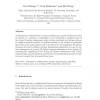Free Online Productivity Tools
i2Speak
i2Symbol
i2OCR
iTex2Img
iWeb2Print
iWeb2Shot
i2Type
iPdf2Split
iPdf2Merge
i2Bopomofo
i2Arabic
i2Style
i2Image
i2PDF
iLatex2Rtf
Sci2ools
TCS
2008
2008
Algorithms for subsequence combinatorics
A subsequence is obtained from a string by deleting any number of characters; thus in contrast to a substring, a subsequence is not necessarily a contiguous part of the string. Counting subsequences under various constraints has become relevant to biological sequence analysis, to machine learning, to the analysis of categorical time series in the social sciences, and to the theory of word complexity. We present theorems that lead to efficient dynamic programming algorithms to count (1) distinct subsequences in a string, (2) distinct common subsequences of two strings, (3) matching joint embeddings in two strings, (4) distinct subsequences with a given minimum span, and (5) sequences generated by a string allowing characters to come in runs of a length that is bounded from above. Key words: subsequence, combinatorics, dynamic programming, algorithm, distinct, common, span, run, sociology, DNA sequencing, microarray
Related Content
| Added | 15 Dec 2010 |
| Updated | 15 Dec 2010 |
| Type | Journal |
| Year | 2008 |
| Where | TCS |
| Authors | Cees H. Elzinga, Sven Rahmann, Hui Wang |
Comments (0)

